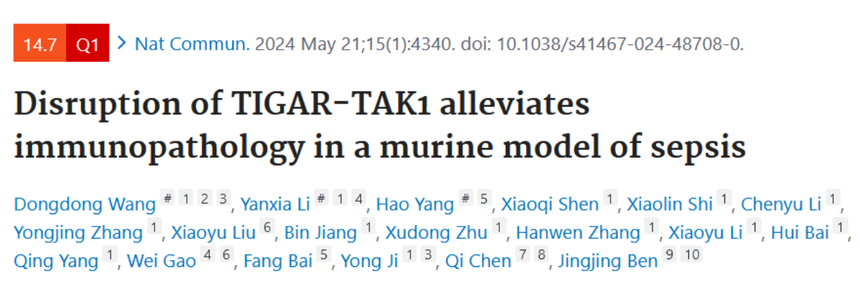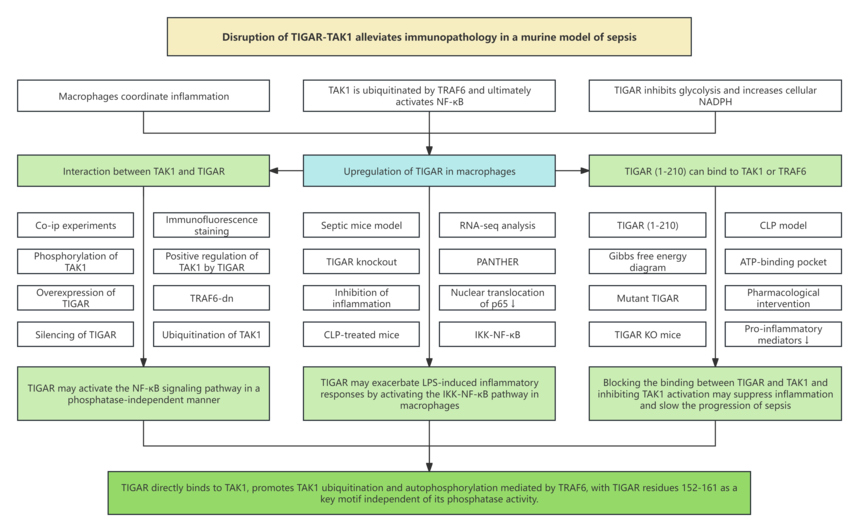Please click the button below to go to our email login page
|
IF of 14.7! “Cellular Inflammation” Related Research Ideas! A New Regulatory Target Discovered by Qi Chen’ Team at Nanjing Medical UniversityInflammation is an important component of biology, which can protect the body and maintain the integrity of tissue and organ function and structure, shielding them from adverse environmental factors. So, what are some research ideas related to cellular inflammation? Let’s explore this together today.
Next, we will share a paper published in the journal Nature Communications, with an IF of 14.7, hoping to bring you some fresh inspiration.
1. Research background 1.1 Macrophages are major innate immune cells present in multiple organs and exhibit functional plasticity in various diseases, coordinating inflammation. 2.2 Transforming growth factor β-activated kinase (TAK1) is a key kinase promoting inflammation in macrophages. After being ubiquitinated by TRAF6, it undergoes autophosphorylation, activates IKK, and ultimately activates the transcription factor NF-κB. 2.3 Metabolic kinases not only regulate energy production, catabolism, and anabolism but also act as signaling molecules to modulate various protein substrates and key cellular processes, including inflammation. 2.4 TP53-induced glycolysis and apoptosis regulator (TIGAR) is a downstream target gene of p53 and shares similar structures with fructose-2,6-bisphosphatase. It inhibits glycolysis and increases cellular NADPH levels to activate the pentose phosphate pathway.
2. Technical methods
3. Research results 3.1 TIGAR in macrophages exacerbates sepsis in mice. 3.2 TIGAR promotes inflammatory responses in macrophages. 3.3 TIGAR stimulates inflammation by activating the IKK-NF-κB signaling pathway in macrophages. 3.4 TIGAR activates the NF-κB signaling pathway via promoting TAK1 phosphorylation in macrophages. 3.5 TIGAR boosts TAK1 ubiquitination by facilitating the interaction between TRAF6 and TAK1. 3.6 TIGAR residues 152-161 are crucial for TAK1 activation. 3.7 Pharmacological inhibition of TIGAR binding to TAK1 antagonizes sepsis in mice.
4. Research conclusion This study, through construction of a mouse sepsis model, reveals the upregulation of the apoptosis regulator TIGAR in macrophages. When TIGAR in macrophages is eliminated, sepsis in male mice induced by lipopolysaccharide or cecal ligation and puncture is alleviated through suppressing inflammation. Mechanistic studies indicate that TIGAR directly binds to TAK1, promoting TAK1 ubiquitination and autophosphorylation mediated by TRAF6, during which TIGAR residues 152-161 form a key motif independent of its phosphatase activity. Treatment with 5Z-7-oxozeaenol to disrupt the binding between TIGAR and TAK1 demonstrates therapeutic efficacy in the male mouse sepsis model. These findings uncover the unconventional function of TIGAR in macrophages in promoting inflammation, and provide a potential therapeutic target for the treatment of sepsis by disrupting the TIGAR-TAK1 interaction. |


